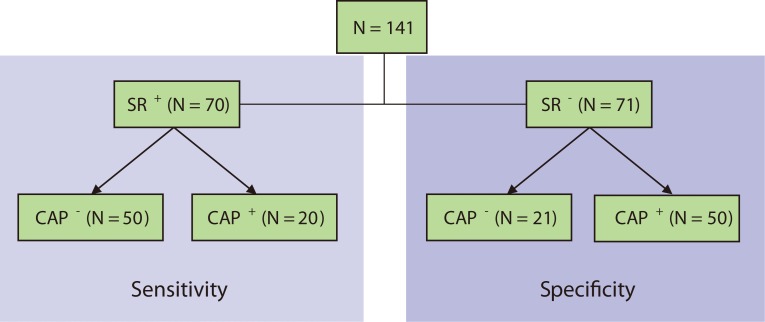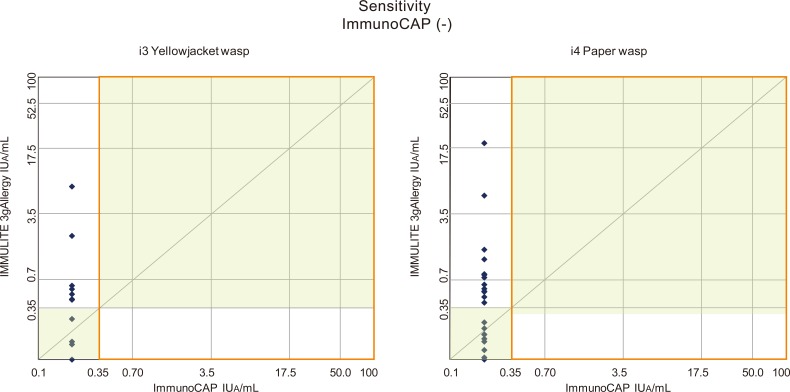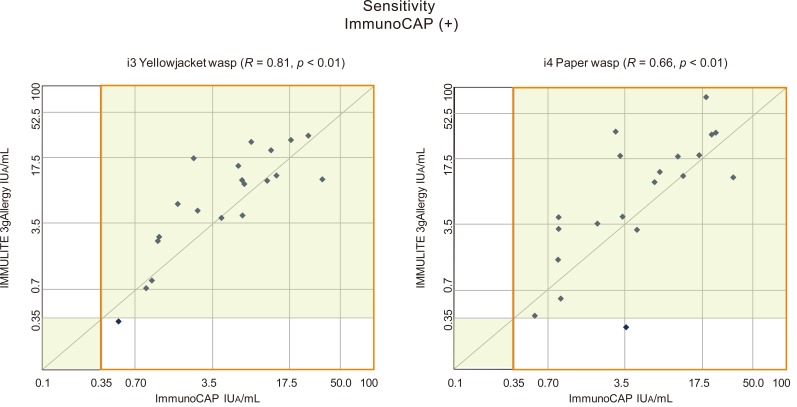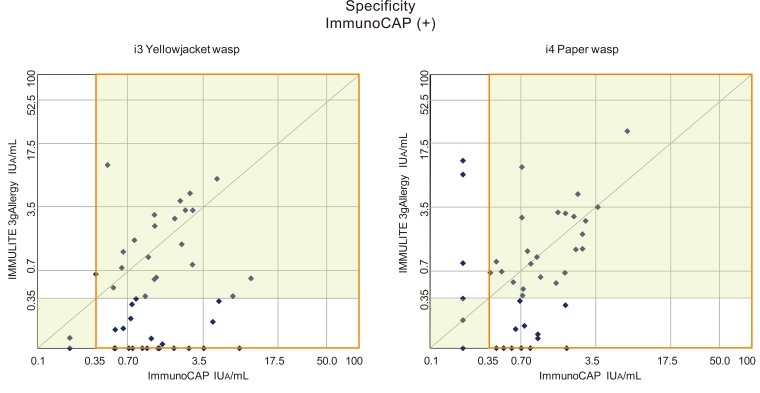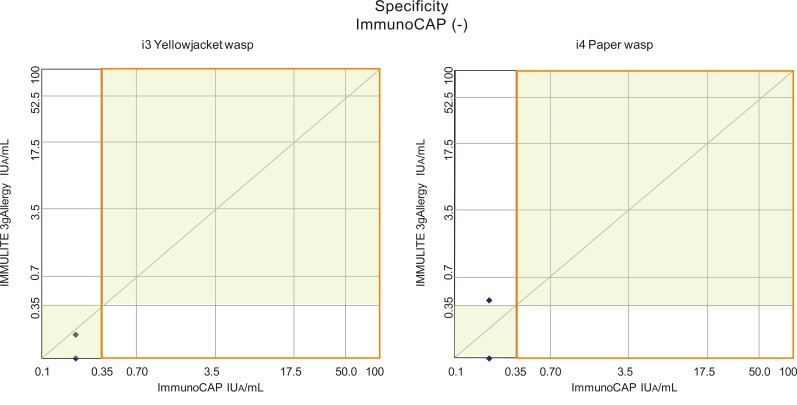Asia Pac Allergy.
2012 Jul;2(3):195-202. 10.5415/apallergy.2012.2.3.195.
Measurement of Hymenoptera venom specific IgE by the IMMULITE 3gAllergy in subjects with negative or positive results by ImmunoCAP
- Affiliations
-
- 1Department of Pulmonary Medicine and Clinical Immunology, Dokkyo University School of Medicine, Tochigi 321-0293, Japan. hirokuni@dokkyomed.ac.jp
- 2Department of Developmental Genetics, Chiba University Graduate School of Medicine, Chiba 263-8522, Japan.
- KMID: 2397482
- DOI: http://doi.org/10.5415/apallergy.2012.2.3.195
Abstract
- BACKGROUND
Patients may receive negative results from a specific IgE (sIgE) test such as the ImmunoCAP (CAP) despite a documented history of systemic reaction to a Hymenoptera sting. Thus, further testing may be required using another serological method or venom skin prick tests to confirm allergy diagnosis and correct species.
OBJECTIVE
To evaluate the sensitivity and the specificity of CAP and IMMULITE 3gAllergy (IMMULITE) for detecting sIgE to Paper wasp (WA) and Yellow Jacket (YJ) venoms using patient clinical history as the comparator.
METHODS
Sera from 70 participants with a history of systemic reactions (SR) to WA and/or YJ stings were tested using CAP and IMMULITE. Fifty participants from this group had negative results on CAP. To assess specificity, sera from 71 participants who had never experienced either a WA or YJ sting were tested using CAP and IMMULITE. Fifty participants from this group tested positive using CAP.
RESULTS
In participants with a history of systemic reaction to a Hymenoptera sting, yet who tested negative for WA and/or YJ sIgE according to CAP, the positivity rate according to IMMULITE was 20-42% using 0.10 IUA/mL as the limit of detection (LoD), per the manufacturer's specification. When the LoD for CAP (0.35 IUA/mL) was applied to the IMMULITE results, positivity according to IMMULITE was 14-26%. Overall, sensitivity, specificity, and agreement with SR were greater for IMMULITE than for CAP. For YJ: sensitivity (IMMULITE:CAP), 42.8%:28.5%; specificity, 53.5%:39.4%; agreement, 48.2%:34%. For WA, sensitivity (IMMULITE:CAP), 58.6%:28.5%; specificity, 49.3%:47.8%; agreement, 43.9%:38.3%.
CONCLUSION
The IMMULITE performed well for detecting sIgE to Hymenoptera venom
Keyword
MeSH Terms
Figure
Cited by 1 articles
-
In this issue of Asia Pacific Allergy
Sang-Heon Cho
Asia Pac Allergy. 2012;2(3):165-166. doi: 10.5415/apallergy.2012.2.3.165.
Reference
-
1. Plebani M, Borghesan F, Faggian D. Clinical efficiency of in vitro and in vivo tests for allergic diseases. Ann Allergy Asthma Immunol. 1995; 74:23–28. PMID: 7719878.2. Shoji J, Kato H, Kitazawa M, Inada N, Sawa M. Evaluation of staphylococcal enterotoxin-specific IgE antibody in tears in allergic keratoconjunctival disorders. Jpn J Ophthalmol. 2003; 47:609–611. PMID: 14636854.
Article3. Ogino S, Bessho K, Harada T, Irifune M, Matsunaga T. Evaluation of allergen-specific IgE antibodies by MAST for the diagnosis of nasal allergy. Rhinology. 1993; 31:27–31. PMID: 8321979.4. Nakagawa T, Miyamoto T, Akiyama K, Takasaka T, Kobayashi S, Nakazawa T, Ito K, Iikura Y, Baba M, Okuda M. Evaluation of allergen-specific IgE antibody and total IgE with a new IgE detection system named FAST: fluorescence allergosorbent test. Arerugi. 1992; 41:93–105. PMID: 1567287.5. Sabbah A, Langlois P. The Pharmacia CAP system as a new measure of specific IgE. Application in the diagnosis of hypersensitivity to the venom of the Vespula wasp. Allerg Immunol (Paris). 1990; 22:173–178. PMID: 2198045.6. Leimgruber A, Lantin JP, Frei PC. Comparison of two in vitro assays, RAST and CAP, when applied to the diagnosis of anaphylactic reactions to honeybee or yellow jacket venoms. Correlation with history and skin tests. Allergy. 1993; 48:415–420. PMID: 8238797.7. Ollert M, Weissenbacher S, Rakoski J, Ring J. Allergen-specific IgE measured by a continuous random-access immunoanalyzer: interassay comparison and agreement with skin testing. Clin Chem. 2005; 51:1241–1249. PMID: 15905313.
Article8. Namai S, Ikemori R, Makino S. Comparison of Swedish and Japanese venom antigens in the diagnosis of Hymenoptera hypersensitivity in Japan. Asian Pac J Allergy Immunol. 1983; 1:143–148. PMID: 6681006.9. Krishna MT, Ewan PW, Diwakar L, Durham SR, Frew AJ, Leech SC, Nasser SM. Diagnosis and management of hymenoptera venom allergy: British Society for Allergy and Clinical Immunology (BSACI) guidelines. Clin Exp Allergy. 2011; 41:1201–1220. PMID: 21848758.
Article10. Shimizu T, Hori T, Tokuyama K, Morikawa A, Kuroume T. Clinical and immunologic surveys of Hymenoptera hypersensitivity in Japanese forestry workers. Ann Allergy Asthma Immunol. 1995; 74:495–500. PMID: 7788517.11. Lee YW, Sohn JH, Lee JH, Hong CS, Park JW. Allergen-specific IgE measurement with the IMMULITE 2000 system: intermethod comparison of detection performance for allergen-specific IgE antibodies from Korean allergic patients. Clin Chim Acta. 2009; 401:25–32. PMID: 19056369.
Article12. Grunwald T, Bockisch B, Spillner E, Ring J, Bredehorst R, Ollert MW. Molecular cloning and expression in insect cells of honeybee venom allergen acid phosphatase (Api m 3). J Allergy Clin Immunol. 2006; 117:848–854. PMID: 16630944.
Article13. Sampson HA, Muñoz-Furlong A, Campbell RL, Adkinson NF Jr, Bock SA, Branum A, Brown SG, Camargo CA Jr, Cydulka R, Galli SJ, Gidudu J, Gruchalla RS, Harlor AD Jr, Hepner DL, Lewis LM, Lieberman PL, Metcalfe DD, O'Connor R, Muraro A, Rudman A, Schmitt C, Scherrer D, Simons FE, Thomas S, Wood JP, Decker WW. Second symposium on the definition and management of anaphylaxis: summary report--Second National Institute of Allergy and Infectious Disease/Food Allergy and Anaphylaxis Network symposium. J Allergy Clin Immunol. 2006; 117:391–397. PMID: 16461139.
Article14. Mueller HL. Diagnosis and treatment of insect sensitivity. J Asthma Res. 1966; 3:331–333. PMID: 4380730.
Article15. Biló BM, Rueff F, Mosbech H, Bonifazi F, Oude-Elberink JN. Diagnosis of Hymenoptera venom allergy. Allergy. 2005; 60:1339–1349. PMID: 16197464.
Article16. Hamilton RG, Mudd K, White MA, Wood RA. Extension of food allergen specific IgE ranges from the ImmunoCAP to the IMMULITE systems. Ann Allergy Asthma Immunol. 2011; 107:139–144. PMID: 21802022.
Article17. Hemmer W, Focke M, Kolarich D, Wilson IB, Altmann F, Wöhrl S, Götz M, Jarisch R. Antibody binding to venom carbohydrates is a frequent cause for double positivity to honeybee and yellow jacket venom in patients with stinging-insect allergy. J Allergy Clin Immunol. 2001; 108:1045–1052. PMID: 11742287.
Article18. März L, Kühne C, Michl H. The glycoprotein nature of phospholipase A2, hyaluronidase and acid phosphatase from honey-bee venom. Toxicon. 1983; 21:893–896. PMID: 6658811.
Article19. Mari A, Iacovacci P, Afferni C, Barletta B, Tinghino R, Di Felice G, Pini C. Specific IgE to cross-reactive carbohydrate determinants strongly affect the in vitro diagnosis of allergic diseases. J Allergy Clin Immunol. 1999; 103:1005–1011. PMID: 10359878.
Article
- Full Text Links
- Actions
-
Cited
- CITED
-
- Close
- Share
- Similar articles
-
- Erratum: Measurement of Hymenoptera venom specific IgE by the IMMULITE 3gAllergy in subjects with negative or positive results by ImmunoCAP
- Clinical Significance of Past History on the Preceding Reaction to Bee Sting and Specific IgE Antibody to Bee Venom in Patients with Bee Sting Anaphylaxis
- Clinical Features and the Diagnostic Value of Component Allergen-Specific IgE in Hymenoptera Venom Allergy
- A case of anaphylaxis by ant (Ectomomyrmex spp.) venom and measurements of specific IgE and IgG subclasses
- Clinical characteristics of total IgE in pediatric allergic disease

